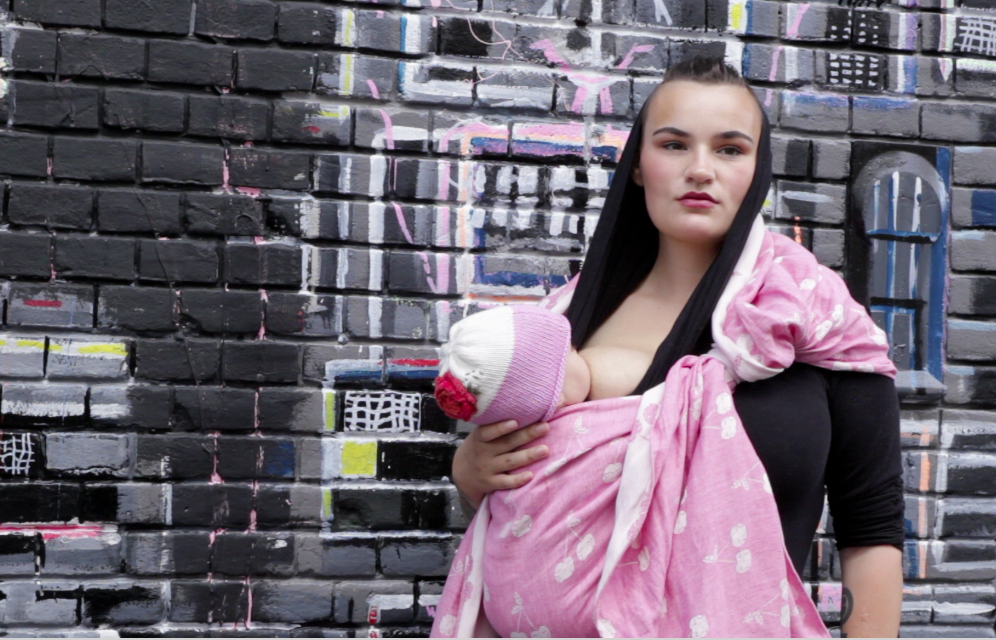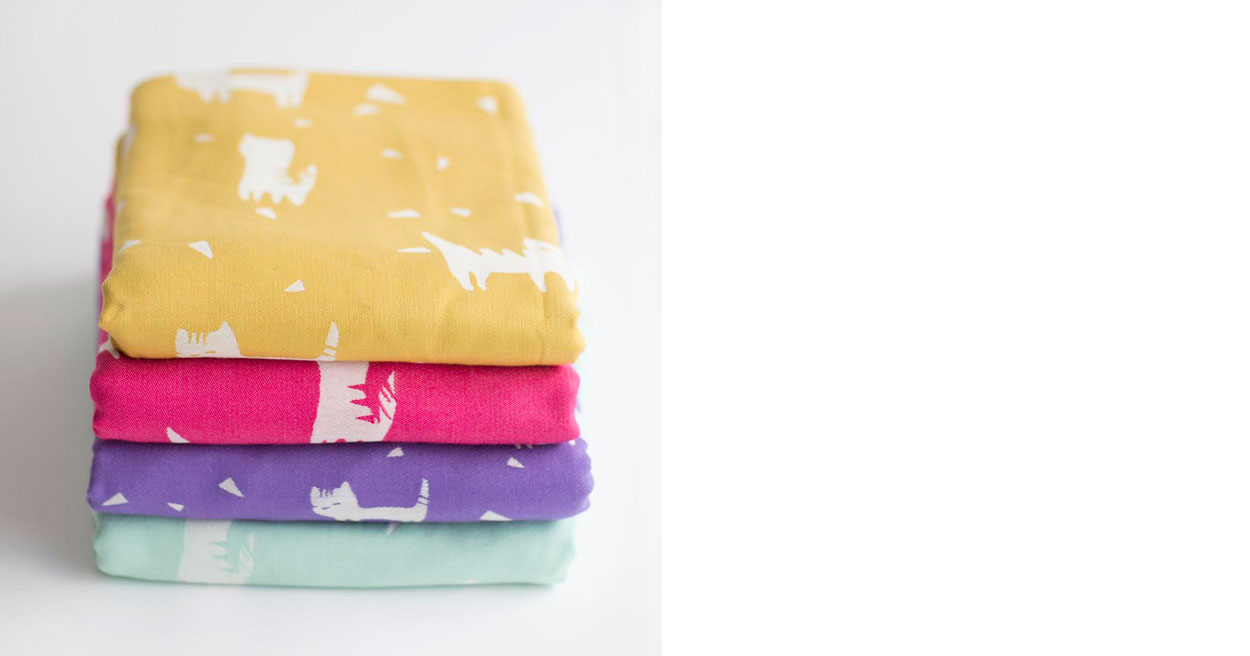10 reasons to wear your baby!
Babywearing is the act of wearing your baby close to your heart in a carrier, sling, ringsling or meitai. I so love it. So what is it that I love about it? Well.. Here’s 10 reasons to wear your baby!
1. Health of Baby
Close physical contact and skin on skin contact are so important for newborns! It’s one of the most vital needs of babies. Even newborns that were struggling to live, started breathing after being put on their moms’ chest. Skin on skin contact, literally reloads your child’s battery when it seems empty!
In 2010 a baby was born prematurely at 27 weeks old to Kate and David Ogg. ‘The doctor asked me had we chosen a name for our son,’ said Kate Ogg. ‘I said, “Jamie”, and he turned around with my son already wrapped up and said, “We’ve lost Jamie, he didn’t make it, sorry”. ‘
‘It was the worse feelings I’ve ever felt. I unwrapped Jamie from his blanket. He was very limp. I took my gown off and arranged him on my chest with his head over my arm and just held him. He wasn’t moving at all and we just started talking to him. We told him what his name was and that he had a sister. We told him the things we wanted to do with him throughout his life. Jamie occasionally gasped for air, which doctors said was a reflex action. But then I felt him move as if he were startled, then he started gasping more and more regularly. I gave Jamie some breast milk on my finger, he took it and started regular breathing.’
Kate Ogg held her 5 month old sleeping son, fully recovered, in her arms as she spoke on the Australian TV show Today Tonight.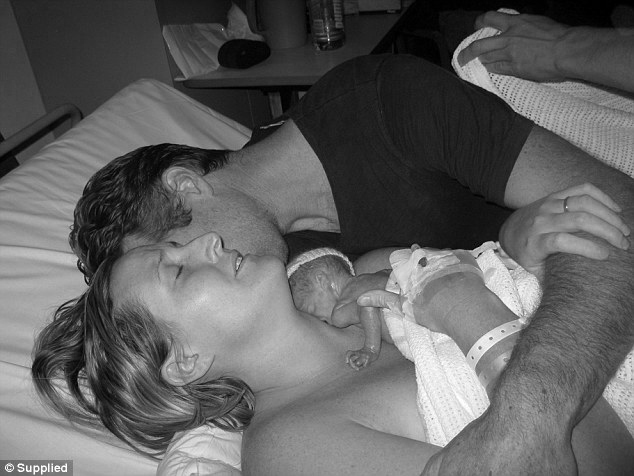
Photo by supplied for Mail Online
Nowadays, many neonatal intensive care units practice kangaroo care. Kangaroo care, named for the similarity to how certain kangaroos carry their young, was initially developed to care for preterm infants in areas where incubators are either unavailable or unreliable. It allows the mother to act as a human incubator to keep her baby warm, stimulated and fed. The parent’s stable body temperature helps to regulate the newborn’s temperature more smoothly than an incubator, and allows for readily accessible breastfeeding when the mother holds the baby this way. And besides that, it ensures also psychological, emotional warmth and aids this position in bonding!
Also babies that are not born prematurely, can benefit from all the positive effects of Kangaroo Care, by being worn in a carrier or a sling and being kept close to your body!
2. Less stress
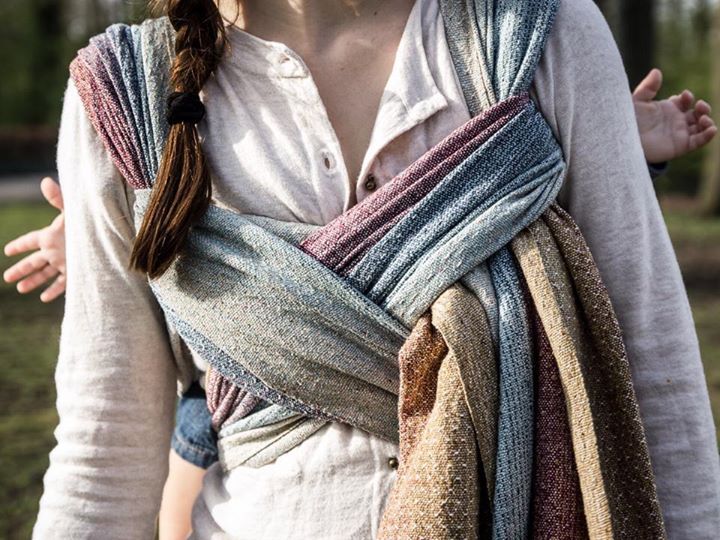
Me with a handwoven Vintage Unicorn by Kokoro (photo made by Pablo Nunez)
A baby in a carrier or sling are protected from overstimulation by the world around them, feeling safe and snug close to her mother’s smell and her heartbeat next to her (or father’s or caregiver’s heartbeat and smell!). She can safely observe the world around her from the belly of her most beloved people.
Also, a baby this close to her caretaker doesn’t have to make big gestures or sounds to communicate her needs. She doesn’t have to cry to be heard. She can make subtle sounds and doesn’t have to stress or worry about being heard or taken care of. She knows she doesn’t have to scream and worry to have her needs met, for example the need for a clean diaper, food or physical closeness.
So she experiences less overstimulation and less worry wether her needs are met, which means less stress for the baby and therefor a stronger immune system and her energy can be kept for growing and developing herself.
3. Bonding to Papa
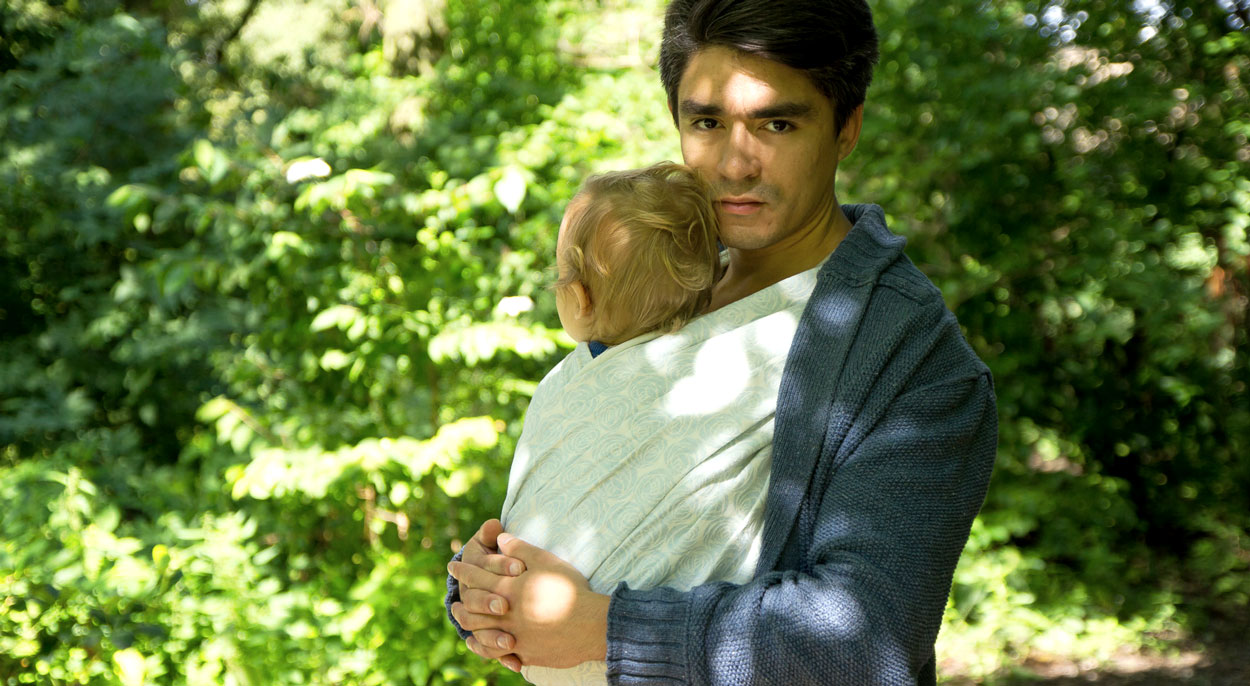 Pablo with our son in Oscha’s Roses Chambray (Photo made by me)
Pablo with our son in Oscha’s Roses Chambray (Photo made by me)
I so love seeing newborn dads out in the park with their little ones in the sling or carrier! Babywearing is not only helpful for moms, but also for dads! Fathers don’t have their babies 9 months in their bellies and therefor they have a bit of a different start. Through babywearing, a father can create a strong attachment with his child as well. While baby gets used to dads movements, his heartbeat, his voice and his facial expressions, dad gets used to his baby’s movements, sounds, expressions and signaling of needs. Also other caregivers, like grandparents, daycare nurses and babysitters can build a bond through babywearing while baby snuggles up in the sling against them.
4. Boost Milk-production
Rose Kotasek (Carry Them and Kokoro) breastfeeding in a sling by Kokoro (photo by me)
Are you trying to breastfeed your newborn? And are you having trouble with milk production? One of the things that stimulates milk production, is close and relaxed physical contact between mother and child. Especially skin-on-skin contact between mother and newborn, stimulates milk production. So if you’re a bit low on milk, grab a sling because babywearing can aid perfectly in breastfeeding, especially when you wear your newborn skin-on-skin, for example at home.
Besides that benefit, babywearing can also make it physically easy to breastfeed on those moments when your little one wants milk, but you are not able to sit down for a calm and quiet feed with your baby, like when you are walking or busy with your other child. In those cases too, a sling can come in super handy, because you can breastfeed while baby’s in the sling and keep on walking of finish what you were doing with your other child!
5. Parents More Confident
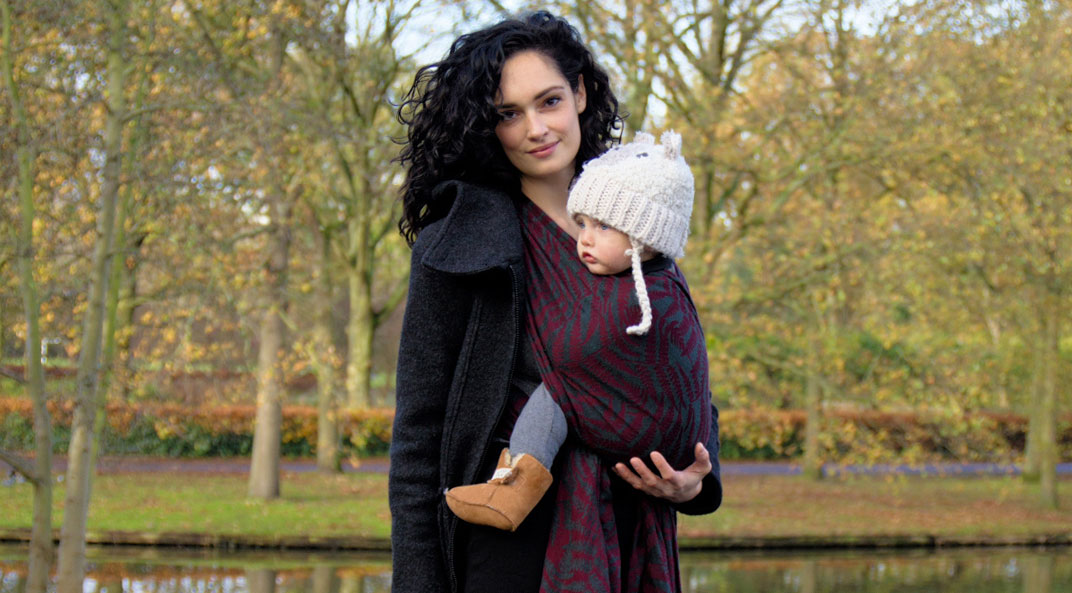 Caroline with Bracken by Sling Studio (Photo by me)
Caroline with Bracken by Sling Studio (Photo by me)
Holding your baby close in a sling allow you to become finely attuned to their movements, gestures, and facial expressions. The more close physical contact there is, the more a mothers’ instincts get stimulated. Not only does it boost milk production, but also it boosts a hormonal 6th sense of moms!
But not only moms, but also dads experience a boost in confidence when practicing baby wearing. You can more easily sense when baby is growing restless and starts wiggling a bit or feels hungry and the mouth starts looking for food. So you can easily respond to your baby, before he’s in distress and his sounds become disturbing and upsetting.
And because baby is there, right under your nose, she (he) knows what caused his upset or change in behavior. You’ll have to guess less often what your child is trying to say and this can help you feel more confident in your parenting.
6. Independence
Sometimes parents are afraid that too much physical affection and closeness will spoil their babies or will not “teach them to be independent”. These ideas are often passed from one generation to another and is actually stemming from a few centuries ago. And these ideas are still prevalent in our modern society today, despite the evidence of scientific research.
Luckily the times are changing and more and more people come to know about the benefits of physical and emotional closeness and that the opposite of this old idea true: having close physical contact stimulates a babies’ emotional, physical and intellectual wellbeing.
Aletha Solter writes about this in The Aware Baby:
“In a study researchers had found that infants whose mothers held them for long periods of time, during the first 3 months of life, tended to be fairly independent by the end of the first year. Although they enjoyed being held, they didn’t mind being put down, and were able to play independently at times.
On the other hand, infants who were only held for brief periods at the beginning showed ambivalence towards the end of the first year. They didn’t seem to enjoy being held very much, yet protested when put down, and did not readily play independently. It was clear from this study that the infants who were acting “spoiled” were the ones who had not been held enough.”
7. Babies with communication skills
I wrote above, that the closeness between parent and child helps the parent to pick up on the early subtle signals of communication of the infant and respond to them. And the beauty of that is, that research has shown that
“mothers who were the most prompt and responsive had babies who became less fussy and demanding, but not at all passive! Instead, the babies developed other modes (besides crying) of communicating their needs at an early age”. (Aletha Solter, The Aware Baby)
So babies can communicate using ’their subtle modes’, like getting a bit wiggly when they need to pee or poo or smacking their lips when hungry. They don’t need to “yell” for it and learn that they don’t need to “yell” whenever they want something. They don’t have to be afraid of not being heard, because their trust that they’re heard and taken care of hasn’t been broken.
8. Hands free
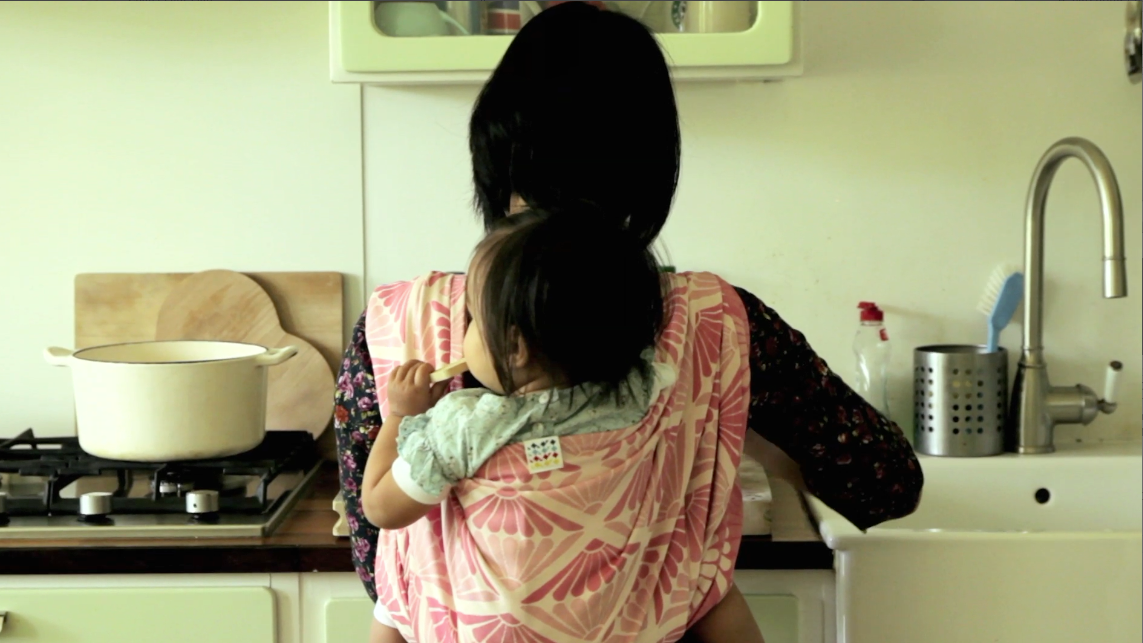 Adisti van Os with Kairos by Kokoro (Photo made by Pablo Nunez)
Adisti van Os with Kairos by Kokoro (Photo made by Pablo Nunez)
Babywearing is super practical. With babywearing, you’ll have your hands free. You can grab yourself a tea, without your little one crying her lungs out alone in her playpen. Or you can take a walk together in the park and there won’t be any crying when she wakes up. You won’t be wondering how to get home with your baby in one arm, while your other hand is trying to steer that big baby wagon through the street, because you will have your hands free and can use them to cuddle your baby as for other things. You can step in and out of the bus, train, tram just like anyone else. You can prepare a meal together or eat a meal yourself with baby “in your arms” in the sling. And even if you have to go to more stimulating environments like a supermarket or a children’s birthday party, your baby is protected from overstimulation and can feel safe and snug in the sling, while you have your hands free. So the possibilities are endless!
It’s clear that babywearing offers many possibilities! At the same time, I also want to be careful that babywearing is not a reason to go anywhere with a young baby. Newborns still have to get used to this world and are very sensitive. So while a carrier or sling can offer a little protection against overstimulation, I do recommend to also be cautious of loud and crowded places. When you yourself experience a lot of stress, try to see if you can build in some rest or ways to discharge some tension, because your little one is picking up on this stress as well. And though your hands are free and this really helps to get things done, which is great, a spring cleaning might actually better be left to wait. That said, a sling or carrier remains really super-handy!
9. Community
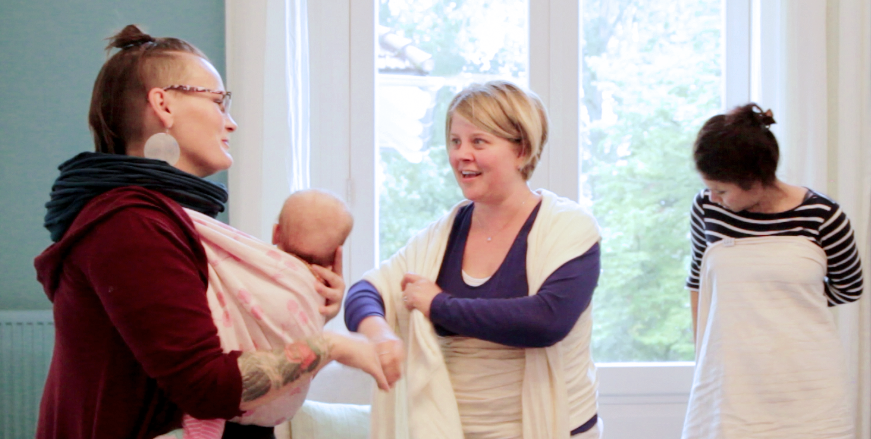 Rose Kotasek of Carry Them and of Kokoro and a lovely mom with wraps by Kokoro
Rose Kotasek of Carry Them and of Kokoro and a lovely mom with wraps by Kokoro
(Photo made by me)
There’s quite a babywearing community in which babywearing mothers connect. Mothers are not only teaching each other how to knot but are also connecting by meeting up and having a tea together, sharing experiences. I organized for a while meetings for Amsterdam Babywearers and I loved going there. This common hobby and interest, makes it easy to bond with other babywearing parents and share experiences. Moms meet each other for help and tips on babywearing. I found that babywearing meetings create a perfect opportunity to have that much needed little chat, support and help for newborn moms whom are so isolated in our individualistic Western societies.
10. Addiction
Kokoro Stash (photo by Kokoro)
Be warned! There’s something called babywearing addiction. Carriers are real fun but slings are truly ad-dic-tive. You know, those beautifully woven textiles, that look like a huge scarf and is sometimes attached to 2 rings (then named a RingSling).
Slings come in different sizes (a 3 to a 7 is most common) and different materials. Stretch wraps and woolblends (woven wraps) are perfectly soft for newborns. Cotton is suitable for all babies and a mix with linen is super strong and therefor suitable for older children (toddlers). So they’re all having a different feel, touch… Aaaah how soft, sturdy, strong they feel!
And if you don’t like all that knotting and want a quick click and go, there’s carriers (also named ‘soft structured carriers’) like Tula, Manduca, Marsupi or Ergobaby. Or an option in between slings and carriers: the meitai. Whatever you choose, make sure that you carry your baby in an ergonomic position, so that it is good for the back of your little one (i.e. face to your breast and not to the outside world!), the hips well spread (frog posture) and that the carrier is also suitable for your back and not dangling loosely on your body!
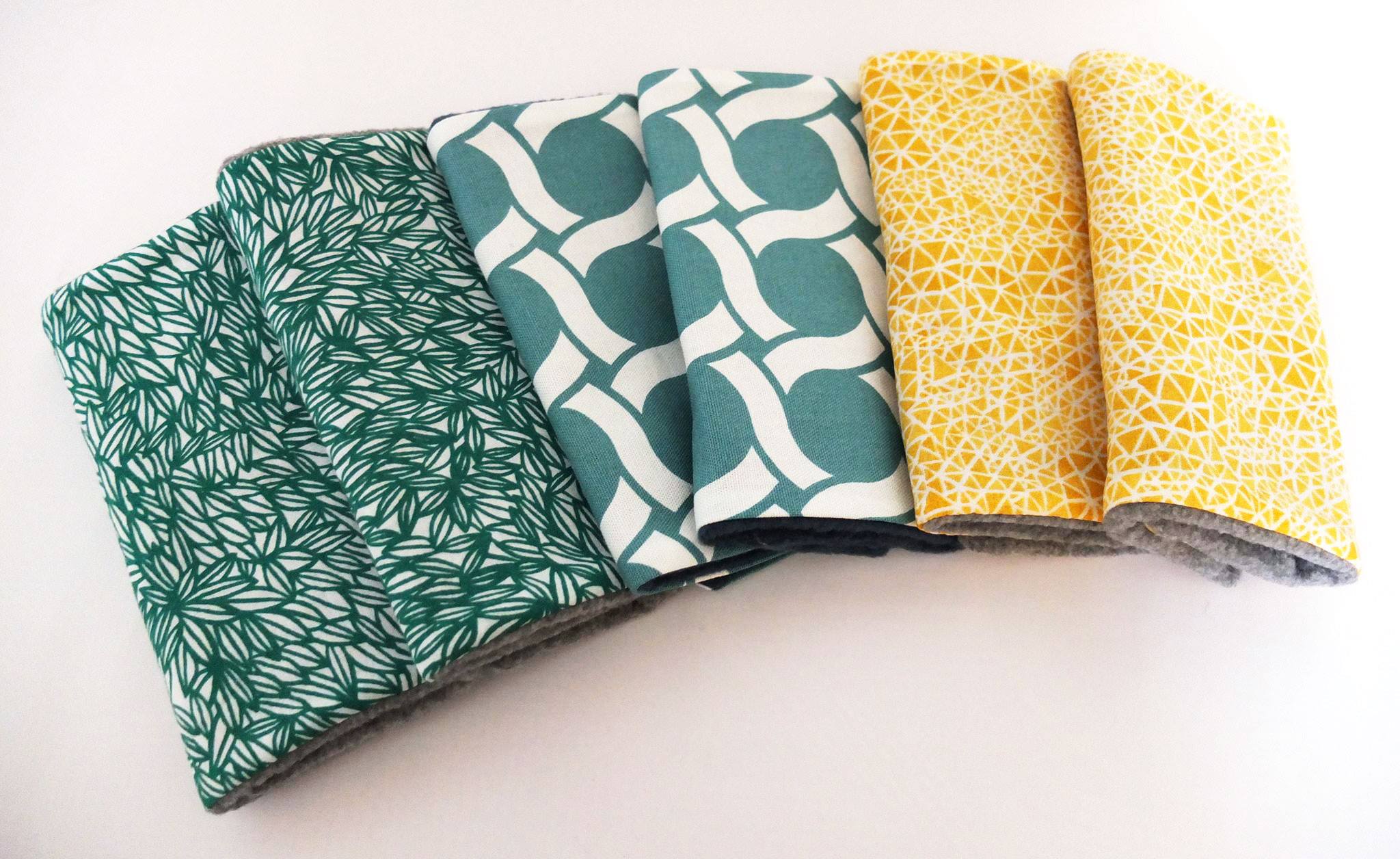
Handmade Organic Teething Pads (Photo by Muismus Amsterdam)
And also for carriers.. there’s some yummy fabrics to get hooked on. What about these teething pads, handmade with high quality organic cotton? Beautiful patterns! Attach them to your carrier so your baby can bite and suck on them safely.
Nowadays there are so many brands in the world of slings and there are so many beautiful designs to choose from! You can buy a more traditional Girasol for a midrange price or a somewhat more expensive Didymos of trustworthy German quality. For the more advanced wearers, there’s the funky handmade designs of Kokoro or the more classical patterns of Oscha.
But whatever brand, color, type you choose.. once you get hooked, it is hard to say no to these beauties!
So..
What about you? What’s your top 5 of reasons to wear your baby? I love hearing from you!

Do you want parenting support?
About the author:
Hi! My name is Chris Muller, MSc, BTA. I am a psychologist, counselor in Transactional Analysis, Aware Parenting instructor (level 2) regional coordinator the Netherlands and mother. For 10 years I provide support to parents through training, the Aware Parenting Education and 1-on-1 guidance. With a lot of love I help you to treat children AND yourself with love and respect. It is my passion that you experience more joy and more connection with your child AND with yourself! X
Free Bookguide
12 tips + explanation
for almost all parenting struggles
without time-outs, rewards or sleeptraining
Would you like to receive my Free Book Guide?
Would you like to receive free tips & updates by email?
Then fill in your email!


